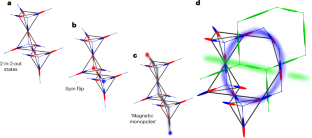Scientists have made a significant breakthrough by confirming the existence of a quantum spin liquid state in a crystal material called pyrochlore cerium stannate. In normal materials, electron spins (which act like tiny magnets) typically align in fixed patterns. However, in this special case, the crystal’s structure creates “magnetic frustration” that prevents the spins from settling down, even at extremely low temperatures.
The research team’s major discovery involves “spinons” – peculiar particles that emerge when a single spin splits into two halves, a phenomenon called fractionalization. These spinons interact by exchanging lightlike particles, similar to how electrons interact through photons in quantum electrodynamics (QED). A key difference is that the “light” in these magnetic materials moves about 100 times slower than the spinons themselves, leading to unique effects like Cherenkov radiation.
The experimental evidence came from sophisticated neutron scattering measurements performed at the Institut Laue-Langevin in France. Using highly specialized equipment, researchers could detect collective spin movements and interactions. Theoretical physicists, particularly at Rice University, developed frameworks to interpret these results and confirm the QED-like behavior in the material.
This research has several important implications. First, it provides some of the strongest experimental proof yet for quantum spin liquid states and their unusual properties. Second, it shows that materials like cerium stannate can host these exotic phases of matter. Third, it opens possibilities for studying other quantum phenomena, including dual particles called visons that carry electric charge. Finally, it has potential applications in quantum computing and related technologies.
The study connects to fundamental physics through its similarity to QED, which forms part of the Standard Model of particle physics. While this quantum state exists in solid materials, it mirrors some of the most basic interactions found in our universe.
The work represents a successful collaboration between experimental physicists from Switzerland and France and theoretical experts from Canada and the U.S. Together, they overcame the significant challenge of obtaining clear evidence for quantum spin liquids, which had been notoriously difficult to verify experimentally.
This discovery creates new opportunities for studying exotic quantum states and their potential technological applications. It also provides a controlled environment for investigating theoretical concepts like magnetic monopoles, bridging the gap between condensed matter physics and high-energy particle physics.
Reference: “Evidence for fractional matter coupled to an emergent gauge field in a quantum spin ice” by Victor Porée, Han Yan, Félix Desrochers, Sylvain Petit, Elsa Lhotel, Markus Appel, Jacques Ollivier, Yong Baek Kim, Andriy H. Nevidomskyy and Romain Sibille, 12 December 2024, Nature Physics. DOI: 10.1038/s41567-024-02711-w

